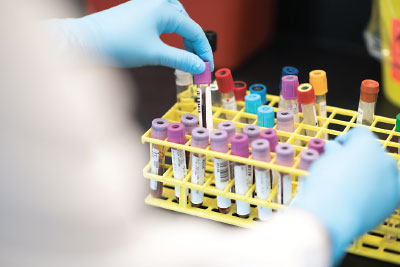Clozapine is the best option for patients with treatment-resistant schizophrenia, but due to the risk of a rare but serious condition known as neutropenia (an abnormal loss of important immune system cells known as neutrophils) people taking clozapine need to have regular blood checks. In the era of COVID-19, however, getting regular tests can be problematic.
“Travel restrictions and shutdowns across the globe are limiting access to sites that can conduct blood tests,” noted Dan Siskind, M.D., Ph.D., an associate professor of medicine at the University of Queensland who specializes in treatment-resistant schizophrenia. To stop the spread of COVID-19, many pathology labs have also reduced staff or working hours, while others have focused their available resources on COVID-19 tests, he noted.
Fortunately, the Food and Drug Administration (FDA) recognizes the difficulties facing patients taking clozapine or other drugs that require certain risk-management protocols. In March, the agency announced it would not take action against health care professionals for failing to adhere to certain Risk Evaluation and Mitigation Strategy (REMS) requirements involving laboratory tests and medical imaging tests for the duration of the COVID-19 public health emergency.
Under the FDA’s Clozapine REMS Program, it is recommended that patients prescribed clozapine have blood tests weekly for the first six months while taking the medication, biweekly for the next six months, and monthly after one year. Though these rules remain in effect, the FDA will not actively enforce the REMS during the pandemic. This means physicians can prescribe, and pharmacists can dispense, clozapine without an up-to-date blood test.
While the FDA did not provide specific new blood testing requirements for clozapine during the pandemic, Siskind and several other schizophrenia experts who are members of the international Treatment Response and Resistance in Psychosis (TRRIP) work group created a guideline they believe might help manage patient risk. Their guidelines were published in the Journal of Psychiatry and Neuroscience.
“We used the best available evidence to strike a balance between the significant risks of neutropenia, especially during an infectious pandemic, versus the risks of patients ceasing their medication and becoming unwell,” Siskind noted. Available clinical data suggest neutropenia risks drop off sharply after the first year of clozapine use, he said.
The TRRIP work group recommended that patients who have been taking clozapine continuously for at least one year can reduce their testing to once every three months provided they have never had their neutrophil levels fall below 2,000/μL (or 1,500/μL if they have benign ethnic neutropenia, a condition observed in some African and Middle Eastern populations).
The work group recommended that physicians evaluate patients who have been taking clozapine for six to 12 months and shown stable neutrophil counts on a case-by-case basis. For patients recently initiated on clozapine, physicians should maintain existing monitoring guidelines in their country.
Even if blood monitoring is reduced in some patients prescribed clozapine, all patients should continue to be evaluated through regular check-ups, Siskind said. In addition to blood risks, clozapine is known to increase risk of cardiometabolic side effects, such as weight gain, which may put patients at higher risk of poor outcomes if they contract COVID-19, he said. Another known clozapine side effect is excess drooling, which can be problematic in people with an infection, as virus-containing saliva may accidentally end up going down the windpipe and increasing the risk of pneumonia in the lungs.
The TRRIP work group recommended that patients on clozapine who develop signs of an infection should have their clozapine dose reduced until at least three days after a fever has subsided. At that point, the physician can slowly titrate the dosage back to the pre-infection levels. As Siskind explained, clozapine is metabolized more slowly during an infection, so standard doses might lead to a toxic buildup in the blood.
“I believe this is an important guideline, irrespective of COVID,” noted Robert Cotes, M.D., an assistant professor of psychiatry and behavioral Sciences at Emory University School of Medicine. “Clinicians need to recognize that any systemic infection can cause clozapine levels to increase.”
Cotes added that obtaining blood clozapine levels as soon as a patient with symptoms of infection presents for medical attention is critical. Since getting COVID-19 blood tests results can take several days in some health systems, physicians should not be afraid to start reducing the clozapine dose before the levels are known and then adjust once the results are in.
Siskind told Psychiatric News that the TRRIP work group is continuing to monitor COVID-19 developments as they relate to schizophrenia and will put forth additional recommendations if needed. ■
The TRRIP consensus statement on the use of clozapine during the COVID-19 pandemic is posted
here.
The FDA’s REMS policy during the COVID-19 pandemic is posted
here.

